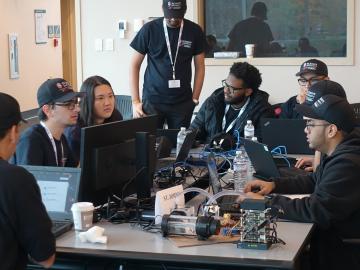
Filter News
Area of Research
- (-) Energy Science (43)
- (-) National Security (10)
- (-) Nuclear Science and Technology (12)
- Advanced Manufacturing (3)
- Biological Systems (1)
- Biology and Environment (10)
- Computational Engineering (1)
- Computer Science (9)
- Fusion and Fission (3)
- Fusion Energy (9)
- Isotopes (1)
- Materials (38)
- Materials for Computing (2)
- Neutron Science (22)
- Quantum information Science (6)
- Supercomputing (63)
News Topics
- (-) Big Data (5)
- (-) Biomedical (6)
- (-) Clean Water (5)
- (-) Computer Science (25)
- (-) Cybersecurity (7)
- (-) Fusion (7)
- (-) Grid (12)
- (-) Machine Learning (6)
- (-) Microscopy (4)
- (-) Quantum Science (2)
- 3-D Printing/Advanced Manufacturing (34)
- Advanced Reactors (12)
- Artificial Intelligence (6)
- Bioenergy (17)
- Biology (2)
- Biotechnology (2)
- Chemical Sciences (2)
- Composites (3)
- Coronavirus (9)
- Energy Storage (21)
- Environment (32)
- Exascale Computing (1)
- High-Performance Computing (1)
- Isotopes (6)
- Materials (2)
- Materials Science (19)
- Mathematics (1)
- Mercury (2)
- Molten Salt (5)
- Nanotechnology (7)
- National Security (2)
- Neutron Science (11)
- Nuclear Energy (33)
- Physics (2)
- Polymers (5)
- Security (7)
- Space Exploration (5)
- Summit (4)
- Transportation (27)
Media Contacts

Scientists at the Department of Energy’s Oak Ridge National Laboratory have developed a new method to peer deep into the nanostructure of biomaterials without damaging the sample. This novel technique can confirm structural features in starch, a carbohydrate important in biofuel production.
A team of scientists led by Oak Ridge National Laboratory found that while all regions of the country can expect an earlier start to the growing season as temperatures rise, the trend is likely to become more variable year-over-year in hotter regions.

Researchers at ORNL demonstrated that sodium-ion batteries can serve as a low-cost, high performance substitute for rechargeable lithium-ion batteries commonly used in robotics, power tools, and grid-scale energy storage.

A novel approach developed by scientists at ORNL can scan massive datasets of large-scale satellite images to more accurately map infrastructure – such as buildings and roads – in hours versus days.

To better determine the potential energy cost savings among connected homes, researchers at Oak Ridge National Laboratory developed a computer simulation to more accurately compare energy use on similar weather days.

While Tsouris’ water research is diverse in scope, its fundamentals are based on basic science principles that remain largely unchanged, particularly in a mature field like chemical engineering.

As scientists study approaches to best sustain a fusion reactor, a team led by Oak Ridge National Laboratory investigated injecting shattered argon pellets into a super-hot plasma, when needed, to protect the reactor’s interior wall from high-energy runaway electrons.

Students often participate in internships and receive formal training in their chosen career fields during college, but some pursue professional development opportunities even earlier.

Oak Ridge National Laboratory will give college students the chance to practice cybersecurity skills in a real-world setting as a host of the Department of Energy’s fifth collegiate CyberForce Competition on Nov. 16. The event brings together student teams from across the country to compete at 10 of DOE’s national laboratories.

Researchers at the Department of Energy’s Oak Ridge National Laboratory have received five 2019 R&D 100 Awards, increasing the lab’s total to 221 since the award’s inception in 1963.


